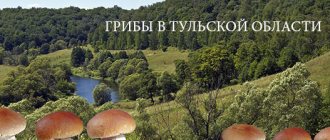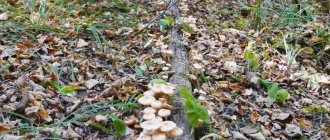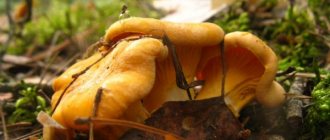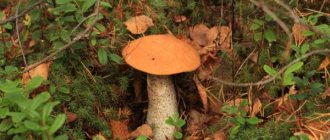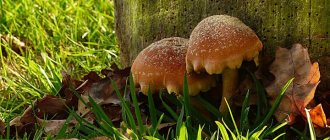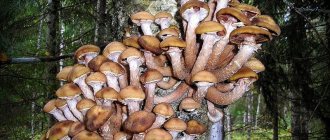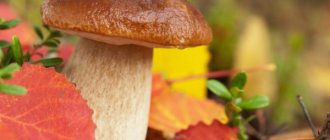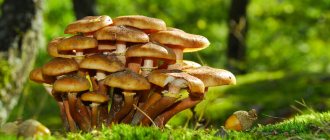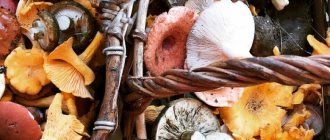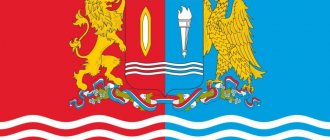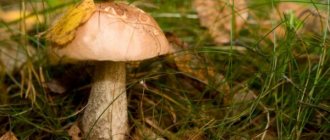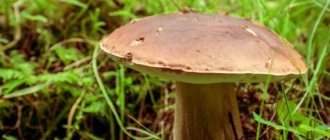On the territory of the Volgograd region there are many places where lovers of walking through the forest in search of a wide variety of mushrooms will find a lot of interesting things for themselves. Over 400 hectares of natural expanses are rich in milk mushrooms, boletus, russula and other noble mushrooms. But it is important to be able to distinguish them from each other and not collect poisonous specimens.
Forest plantations of the Volgograd region
The weather in the Volgograd region is mostly clear and dry, which is not surprising in a very dry climate, so weathering of the topsoil is a real disaster for farmland. Today, 400 hectares of forests grow in the region in natural conditions along the banks of the Volga, Don, Khopra rivers and in ravines. Floodplain forests of the Volgograd region are mainly represented by oak, black poplar and trees and shrubs.
Interesting read: Honey fungus: an edible mushroom that not every mushroom picker knows about.
In addition, over the past 60 years, work has been carried out on artificial planting of forests, the function of which was to protect fields from dry winds. Not all of them were successful, since the composition of the soil and the species of trees and shrubs suitable for it were not always taken into account. But there were also positive results, thanks to which today there are more than 200,000 hectares of artificial green areas in the region, some of which protect the soil from erosion, and some of which are recreational areas for the local population.
Botanical description
An adult white Polish mushroom has a cushion-shaped or flat-shaped cap with a diameter of up to 12-14 cm. In young specimens, the cap has a predominantly semicircular and convex shape. The surface of the cap is covered with a smooth and dry, non-removable skin, which in the wet season can be sticky to the touch. The color of the cap is most often chestnut brown or brownish brown.
The fruiting body of young mushrooms looks attractive and is characterized by slight blue discoloration when broken. The pulp has a very pleasant mushroom aroma and mild taste. The tubular layer is characterized by a free arrangement and the presence of a slight recess. The tubular layer is yellowish or greenish-yellow, with angular pores, and turns blue when pressed.
The average length of the leg does not exceed 8-10 cm. The leg can have either a cylindrical or slightly narrowed or swollen shape at the bottom. There is pronounced fibrousness and a light brown with a yellow tint. The spores are ellipsoid-spindle-shaped, with a smooth surface, brownish-olive in color. It is recommended to collect young mushrooms that have not fully opened caps.
What mushrooms grow in the Volgograd region
If you believe the reviews of mushroom pickers on forums and in the relevant groups, thanks to the impressive size of the forest area in this region, there is a good chance of finding trophies that are rare for Volgograd. If we talk about common ones, then experienced mushroom pickers distinguish:
- honey mushrooms;
- greenfinches;
- milk mushrooms;
- flywheels;
- White mushrooms;
- chanterelles;
- rows;
- Champignon.
There are also dung beetles, as well as boletus, puffballs, boletus, and umbrellas. The latter, for most mushroom pickers, are valuable for their taste, along with porcini mushrooms and champignons.
general information
This mushroom is called Polish for the simple reason that it was previously imported from Poland, where it was considered a noble food. And since earlier in Poland the elite of the state were called lords, this is where the second name came from - lords. The Polish mushroom belongs to the Boletaceae family, the genus Moss mushroom. Some official sources also include it in the boletus genus, for its characteristic features. Among mushroom pickers, chestnut mushroom is very popular for its delicate, pleasant taste and a huge number of cooking methods.
When do mushrooms appear?
Mushrooms grow in the Volgograd region mainly in the autumn. In spring and summer they are practically absent due to the characteristics of this climatic zone. The climate in the Volgograd region is dry. Constant dry winds destroy field plants and mushrooms. Thanks to artificial plantings, people have the opportunity to pick mushrooms from May to October and preserve the harvest in meadows and vegetable gardens.
Mushrooms should be collected in the Volgograd region with special care. A dry, sultry wind that blows moisture out of the soil and carries toxic substances and exhaust gases can make even an edible mushroom poisonous. This is due to the ability of the mycelium to accumulate toxins, therefore, after the first rains, some edible mushrooms are as poisonous as toadstools and fly agaric mushrooms.
- Spring species - chanterelles, dung beetles, boletus.
- Types of summer mushrooms in the Volgograd region - white mushrooms, champignons, boletus, giant puffball, milk mushrooms, moss mushrooms.
Edible mushrooms on the territory of the Volgograd region are rows of mushrooms, honey mushrooms, and greenfinches. Taking into account the peculiarities of the climate of the Volgograd region, we can safely say that the period from the beginning of September to October inclusive is profitable for mushroom pickers. The bulk of edible trophies begin to bear fruit at the end of summer, but it is in September that there is a risk of fungal development.
You will have to spend less time searching for productive places. The only “obstacle” may be a large number of competitors. Mushroom places in the Volgograd region 2022 are of interest even to non-locals. If you are not ready to compete with others for mushrooms, go to the forests in mid-October.
In autumn, the influence of dry winds, which are typical for the Volgograd region, is insignificant, so nothing prevents seasonal trophies from growing.
Inedible and poisonous varieties
Along with healthy, tasty or at least simply edible mushrooms, you can find bitter, caustic or downright poisonous mushrooms in forests, plantings and parks. Anyone who eats such mushrooms will be very lucky if he gets away with a 24-hour vigil in the toilet room and a gastric lavage. Some fruiting bodies, even in small quantities, lead to death in most cases. Recognizing such species is the responsibility of every mushroom picker.
fly agaric
Red fly agaric.
The most famous poisonous mushroom of the temperate zone. True, only one variety is widely known, namely the red fly agaric - white spots are usually scattered on its bright cap. The appearance of the red fly agaric is almost impossible to confuse with other mushrooms. It would seem that this is good, but not always. Many people think that the fly agaric can only have a red cap with white spots, but it has many species, some of which are not colored at all. Ironically, the deadly poisonous mushroom is the stinking fly agaric, which looks like a champignon. The only thing that gives it away is the smell, similar to the smell of chlorine.
Fly agaric contains hallucinogenic substances. This feature of the mushroom was well known in ancient times among various peoples - the ancient Indians, Aztecs and Mayans, and the Vikings. The culture of using fly agarics lasted the longest among the shamans of the Far North. The effect of fly agaric is vaguely reminiscent of the effect of LSD and is accompanied by a “trip,” although at the same time negative physiological consequences are inevitable: nausea, vomiting, pain in the digestive tract.
Satanic mushroom.
Satanic mushroom
It belongs to the same genus as the porcini mushroom, has a similar stem shape, but it is impossible to confuse it with other species: only in its fruiting body it is not the cap that is brightly colored, but the stem. The first is off-white or gray, but the second can be of different colors, from orange to bright crimson.
Although the satanic mushroom is not fatally poisonous, eating it even in small quantities can cause severe stomach upset.
There is information that in some European countries the mushroom is considered conditionally edible, that is, when the liquid is boiled and drained, it loses its toxic properties. However, in French reference books it is classified as poisonous.
Death cap
Death cap.
It is inferior to the fly agaric in popularity and visibility, but outranks it in toxicity. Having eaten toadstool in an amount of only 30 g, you can go straight to the morgue rather than to the hospital. The insidiousness of the mushroom is that the symptoms of poisoning do not appear immediately, but at least 6 hours after eating. During this time, it is already too late to take action.
The risk of putting a toadstool in a box exists even for experienced mushroom pickers. This mushroom does not have a specific odor that would serve as a stop signal. When going into the forest, you should always be careful and it’s better to be “overcautious” than “underdressed.”
Stolyarov Vasily Stepanovich
Expert in Silent Hunting
I have been collecting mushrooms since childhood. I know everything firsthand. Pale toadstool is, of course, a dangerous mushroom, but it is not so difficult to identify. First of all, the skirt. Edible mushrooms do not have these. Secondly, Volva. Well, it's like a cover at the end of the leg. Only it is usually hidden in the ground. Therefore, do not be lazy, do not cut off the dubious mushroom immediately, but examine it properly, without separating it from the mycelium.
— Stolyarov Vasily Stepanovich Expert in silent hunting
Mushroom places of the Volgograd region
According to mycologists, the Volgograd region has more mushrooms on its territory than the Moscow region. The most popular regions are:
- the lowlands in the vicinity of the Tsimlyansk Reservoir are rich in pine and deciduous forests;
- Volga-Akhtuba floodplain;
- many open areas (pastures and meadows) next to the Volgograd reservoir;
- island territories on the Volga.
Many mushroom pickers remember the most productive places where they prefer to go every year, laying out their own paths.
Material on the topic: Description of the mushroom: ringed cap
Real reviews
- Michael
The favorite place for quiet hunting in the Volgograd region is the Volga-Akhtuba floodplain. Now you won’t have to wander around for a long time with empty buckets. My wife and I go for the fragrant milk mushrooms; depending on the weather, we can sometimes find good clearings with porcini mushrooms in mid-September.
- Victoria
My family and I are heading out to the Tsimlyansk Reservoir this weekend closer to autumn. Our favorite boletus grows here. At the height of the season, of course, there are a lot of competitors. As an alternative to the Tsimlyansk Reservoir, sometimes it is chosen a little closer to the farms near the Don, away from the reservoir itself.
- Kirill
Swan Glade is an ideal place to hunt for porcini mushrooms and honey mushrooms. I always leave home with buckets full of trophies.
It is better to study mushroom places in the Volgograd region 2022 in advance so that the quiet hunt is as productive as possible.
Map of mushroom places
People for whom “silent hunting” is a favorite pastime try to remember mushroom places by marking them on the map. This allows you to create an approximate route for next year, including those places where the forest was most generous with autumn gifts. Mushroom pickers observe a massive accumulation of forest gifts in the Tsimlyansky forests of the Chernyshkovsky district, near the village of Panshino in the Gorodishchensky district, the villages of Vityutnev and Ryabovsky, in Lebyazhya Polyana, near the villages of Rudnya, Kuchugury, Surovikino. A large number of mushrooms were noticed in the Chernyshkovsky district.
High humidity near ponds and reservoirs means that in these zones the diversity and number of fungi is significantly higher than in other regions. Each mushroom picker, using the map he has compiled, annually tries to make another “tour” in the fall, visiting already familiar mushroom places in the Volgograd region and adding new, previously unknown ones.
The richest places in mushrooms
There are often conversations about these places on local mushroom forums:
- Rudnya. The village with an unusual name has already managed to please many mushroom pickers with an abundance of assorted mushrooms. Edible and conventional mushrooms are found in large quantities in the vicinity of Lebyazhya Polyana.
- Panshino. A small but fertile village will delight mushroom pickers not only with protein products, but also with unique landscapes and clean air.
- Oak groves The oak groves known to all local residents: Shakinskaya and Kumyzhenskaya are quite extensive. In their territories, mushrooms can be collected in any month, provided the temperature is warm.
- Tsimlyansky forest. Anyone who has not yet visited this beautiful place should go there for a quiet hunt. The deposit characterizes itself as one of the most mushroom-filled in summer and autumn.
- Small oak groves The concept includes almost all deposits located on the border of the Volgograd region.
Local residents have repeatedly mentioned on forums that mushrooms grow here in almost all “green zones”.
Forum, what do they write?
Mushroom places are traditionally discussed on the forum. Among those where, according to the pros, there is a greater chance of collecting a lot of trophies, there are:
- Chernyshevsky district with its Tsimlyansky forest;
- village of Rudnya;
- oak groves Shakinskaya and Kumyzhenskaya on the territory of Kalache-on-Don;
- the villages of Surovikino and Peskovatka;
- Gorodishchensky district (closer to the village of Panshino);
- The surroundings of Lebyazhya Polyana;
- The vicinity of the Ryabovsky farm, Vityutneva, and the village of Trekhovstrovskaya.
- Mushroom pickers deservedly consider the Chernyshevsky district rich in forest gifts, which has good competition from mushroom places in the Kaluga region 2019.
Beneficial features
The Polish mushroom has elastic and dense flesh; as a result of any heat treatment, it slightly loses weight. The aroma of the pulp is characterized as pronounced mushroom, with a slight sweetness. The taste of the finished dish made from these mushrooms is very pleasant, velvety.
The calorie content of 100 g of pulp does not exceed 19.0 kcal, which allows the Polish mushroom to be classified as a dietary product. The chemical composition includes vitamins B1, B2, B9, B12, C and PP. In addition, mushroom pulp is rich in potassium, calcium, magnesium, zinc, selenium, copper and manganese, iron, fluorine, phosphorus and sodium. Eating Polish mushroom helps improve memory and minimizes the risk of atherosclerotic changes. There is an increase in mental activity, nerve cells are renewed, and the general condition of nails and skin and the appearance of hair improves.
